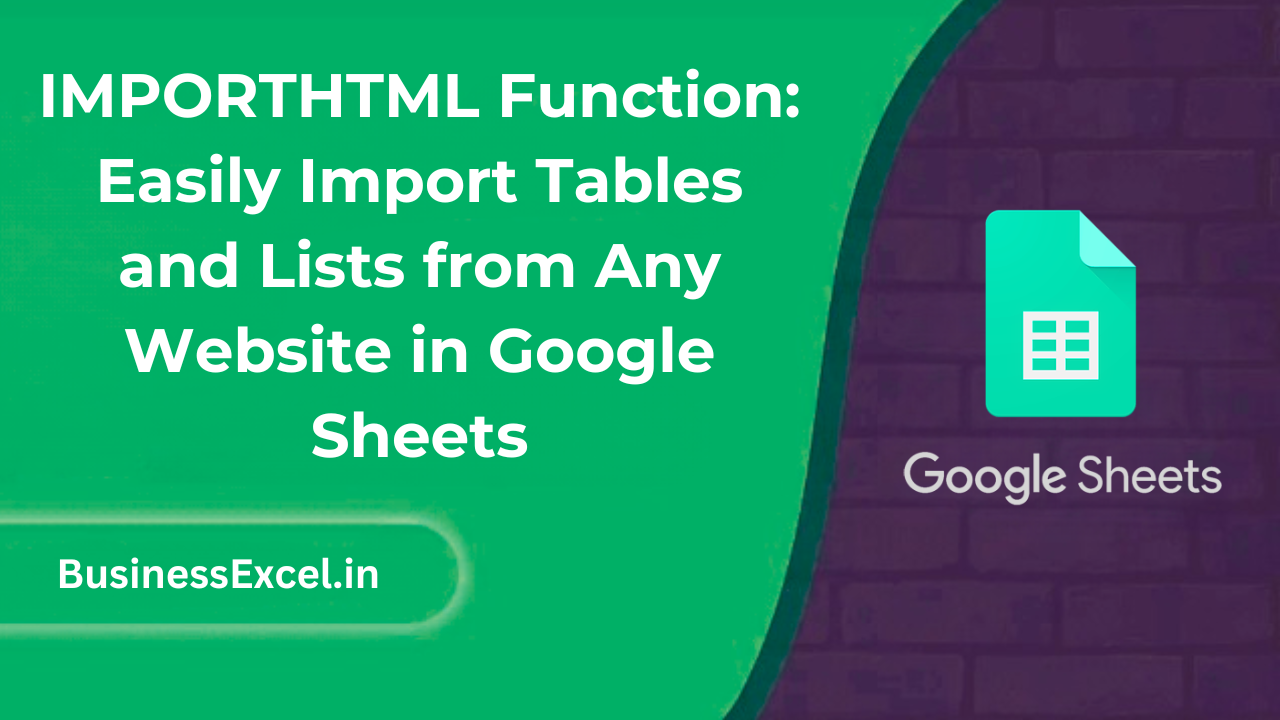Have you ever wished you could pull a live table or list from a website straight into your Google Sheet — without copying and pasting? The IMPORTHTML function does exactly that! Whether you’re tracking stock prices, football scores, or product lists, this handy feature can automatically fetch and update external data right inside your spreadsheet. Today, we’ll walk you through exactly how to use IMPORTHTML in Google Sheets — even if you’re brand new to formulas!

What is the IMPORTHTML Function in Google Sheets?
The IMPORTHTML function lets you pull structured data — specifically tables and lists — from any public web page into your Google Sheet. It updates automatically, meaning if the source website changes, your data can too (depending on refresh settings). This is a fantastic tool for saving time, staying updated, and organising data for analysis or sharing.
Why Is It Useful?
Instead of manually copying data from websites (which can be tedious and error-prone), IMPORTHTML lets you automate the process. It’s especially useful for:
- Real-time price tracking (e.g., cryptocurrency, stock markets)
- Sports scores or event results
- Job postings or classified listings
- Product catalogs from e-commerce websites
Real-Life Example: Importing a Premier League Table
Imagine you’re a big football fan, and you want to track the latest Premier League standings in your Google Sheet. Instead of updating it manually every week, you can use IMPORTHTML to pull the table directly from the official Premier League website. Your spreadsheet stays up-to-date with minimal effort!
Sample Table Example
| Position | Team | Points |
|---|---|---|
| 1 | Manchester City | 89 |
| 2 | Arsenal | 86 |
| 3 | Liverpool | 81 |
Note: This is an example! Real-time standings would be imported dynamically using IMPORTHTML.
Step-by-Step Instructions: How to Use IMPORTHTML
1. Find the URL of the Website
- Go to the website that contains the table or list you want.
- Copy the full URL from your browser’s address bar.
2. Identify Whether You Need a “Table” or “List”
- If the data is arranged in a grid (like a spreadsheet), it’s a table.
- If it’s a simple bullet or numbered list, it’s a list.
3. Enter the IMPORTHTML Formula in Google Sheets
- Click a cell where you want the imported data to start.
- Type the formula:
=IMPORTHTML("URL", "table" or "list", index_number) - Replace:
- URL with the website link (in quotes)
- table or list depending on what you are importing
- index_number with the number if there are multiple tables/lists (e.g., 1 for the first one, 2 for the second)
Example Formula
=IMPORTHTML("https://example.com/premier-league-table", "table", 1)
Key Benefits of Using IMPORTHTML
- Automatic Updates: Your spreadsheet stays synced with the website.
- Save Time: No need to manually copy-paste data.
- Easy to Use: Just one simple formula pulls in all the data.
- Great for Reporting: Create live dashboards or trackers effortlessly.
Pro Tips for Mastering IMPORTHTML
- Check for Public Access: The website must be publicly accessible without login requirements.
- Multiple Tables/Lists: If there are several tables on a page, experiment with the index number (1, 2, 3, etc.) to get the right one.
- Watch for Changes: If the website changes structure, your IMPORTHTML might break — so keep an eye on it for critical reports.
- Refresh Data: Google Sheets generally refreshes IMPORTHTML functions about every 2 hours, or when the document is opened.
Quick-Reference Cheat Sheet
| Element | Details |
|---|---|
| Formula Syntax | =IMPORTHTML(“URL”, “table” or “list”, index) |
| URL | The web address (must be publicly accessible) |
| Query Type | “table” or “list” |
| Index | 1 for the first table/list, 2 for the second, and so on |
| Refresh Rate | Every 2 hours or when the file is reopened |
The IMPORTHTML function is one of the easiest ways to bring live, structured web data into Google Sheets. Whether you’re tracking sports, prices, stock trends, or anything else organised as a table or list, this function can save you tons of time and effort. Once you get the hang of it, you’ll wonder how you ever managed without it! Give it a try today, and open up a whole new world of automated data importing in Google Sheets!